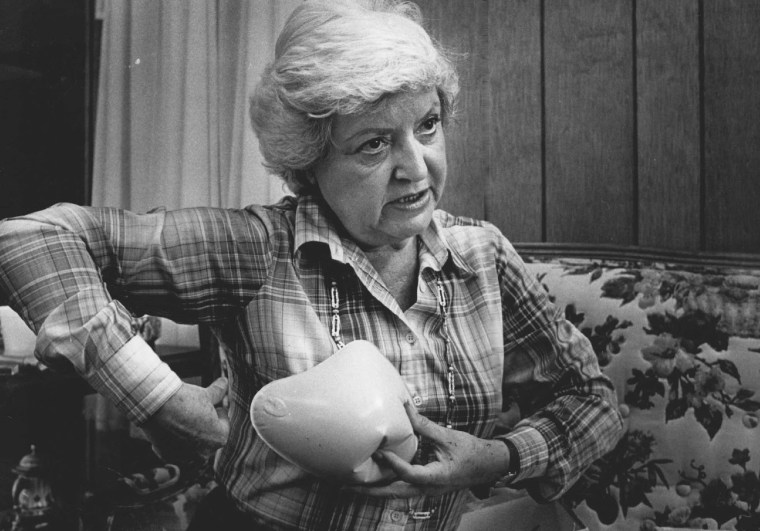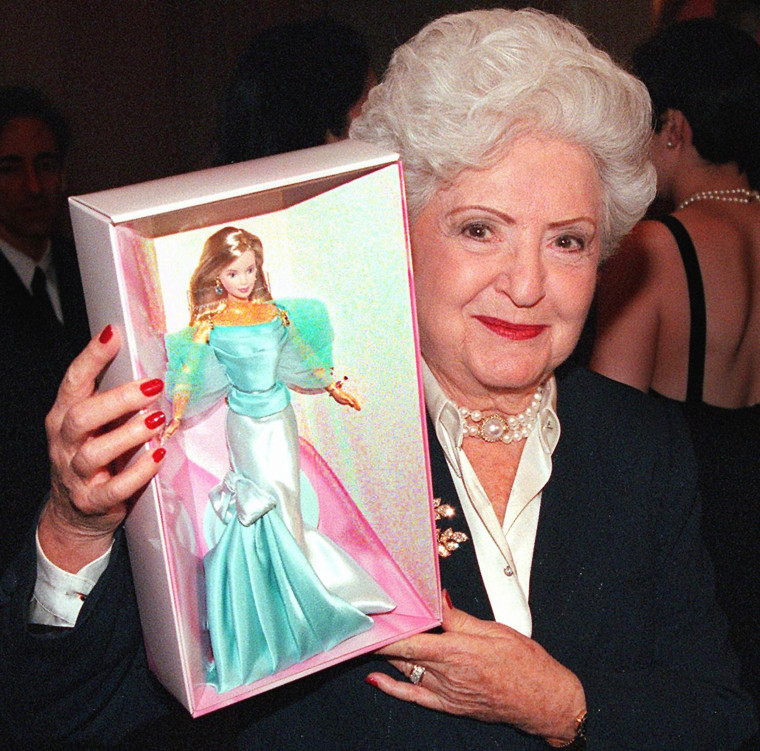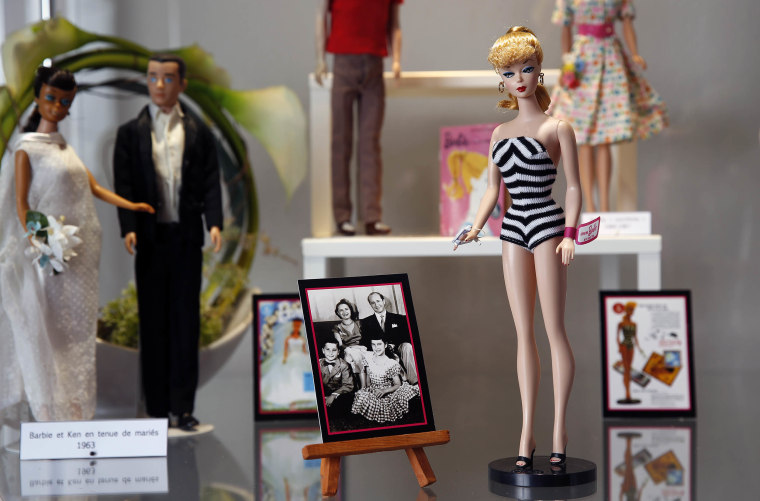Without revealing too many spoilers for the "Barbie" movie, the character of Ruth Handler plays a pivotal role in Barbie's journey.
Played by Rhea Perlman, Handler provides both an emotional center and an edge to the movie, as her character breaks the laws of space and time (well, so does Barbie). Ruth alternates between inspiring Barbie with grandmotherly wisdom and cracking jokes about tax evasion.
The real-life Ruth Handler was, of course, the legendary creator of Barbie herself. Though Handler passed away in 2002, her legacy lives on through her famous doll, which has kept pace with societal trends since its debut in 1959.
Here's everything you need to know about Handler and her role in the Barbieverse.
Ruth's life before Barbie
Ruth Handler, née Moskowicz, was born on November 4, 1916, in Denver, Colorado, per PBS. According to the Jewish Women's Archive, Handler's parents were Jewish immigrants from Poland, and she was the youngest of ten children.
She married her high school boyfriend, Elliot Handler, and moved with him to Los Angeles in 1938. The Handlers had two children: daughter Barbara, born in 1941, and son Kenneth, born in 1944.
Handler and her husband Elliot founded their toy company, Mattel, in 1945. "Mattel" was named after a combination of Elliot's name and the name of one of their colleagues, Harold "Matt" Matson.
Mattel produced a number of successful toys in its earlier years, including the "Uke-A-Doodle" toy ukulele.
Business was good, but not extraordinary, until inspiration struck Ruth Handler on a trip to Germany.
Finding the inspiration for Barbie
The story of how Handler created Barbie has since passed into legend.
Handler had noticed that her daughter Barbara, nicknamed "Barbie," preferred dressing up her grown-up paper dolls to cradling an infant doll.
“Barbie used to love to play with paper dolls," Handler said in a 1994 interview with Lilith Magazine. "We went to the dime store together each Saturday, and I noticed that she always chose teenage dolls, never baby dolls or children dolls, and she and her friends used to play for hours with the teenage dolls. I listened to how they would project their future with their dolls.”
In search of a more mature toy, Handler encountered a German doll called Bild Lilli while vacationing in Europe. The Bild Lilli doll, which had adult proportions and wore real clothes, was originally intended as a somewhat provocative gag gift, but Handler saw potential for a new kind of children's toy — thanks to her own daughter's interest in the doll.
In a 2002 New York Times article with Barbara Handler, she describes how, at 15, she loved playing with the doll.
“I was going crazy because I wanted different clothes for it, and they didn’t sell the clothes separate. You had to buy a different doll every time you wanted a different outfit,” Handler told the New York Times.
“My mother thought, Why is this daughter of mine so crazed about this doll? She bought a couple of them. And when we got back, I never saw them again. They were torn apart and researched, and they got the idea of the separate clothes, and the rest is history.”
Handler named the teenage girl doll after her daughter — and would later name Barbie's counterpart, Ken, after her son.
The original Barbie, full name Barbara "Barbie" Millicent Rogers, was a 19-year-old fashion model doll.
As “Barbie” denotes, part of the doll’s appeal was that she was decidedly not a baby doll. Handler spoke of Barbie’s mature physique in an interview with the New York Times in 1977. “Every little girl needed a doll through which to project herself into her dream of her future. If she was going to do role playing of what she would be like when she was 16 or 17, it was a little stupid to play with a doll that had a flat chest. So I gave it beautiful breasts,” she said.
Released in 1959, the Barbie doll was an instant hit. Mattel sold over 300,000 dolls in the first year of production, per Mattel. The Handlers took Mattel public in 1960, with a valuation of $10 million at the time.
Beyond Barbie, a bumpy road
Despite Barbie's enormous success, it wasn't smooth sailing for the Handlers.
Ruth Handler was diagnosed with breast cancer in 1970 and underwent a mastectomy, per PBS. At the time, there were few nonsurgical ways to reconstruct the chest after a mastectomy. Handler was unable to find a satisfactory breast form, and found stuffing her bra uncomfortable and unrealistic.
In 1976, Handler founded Ruthton Corp. and began to produce a line of prosthetic breasts, called "Nearly Me," for breast cancer survivors.

The "Nearly Me" prostheses were made of liquid silicone, polyurethane, and foam. Handler was known to promote the product by asking people to feel her chest and guess which breast was real. She also trained salespeople to fit women for prosthetic breasts.
Greta Gerwig, who directed “Barbie,” praised Handler’s innovation with the “Nearly Me” breast prostheses.
“She invented inserts into a bra that you could put on after you’ve had a double mastectomy, so you could still feel like yourself,” Gerwig said. “That felt beautiful and poetic. Barbie has always been held up to be a sort of unrealistic physical ideal: impossibly beautiful, and impossible to achieve for a mere mortal. I thought, ‘That is so interesting, because the woman who created her physically went through a transformation in a completely different direction.’”
Oh, so that's what 'Barbie' meant by all those tax evasion references
As well as referencing her mastectomy, Handler's character in "Barbie" makes multiple jokes about tax evasion. In real life, Handler was actually forced out of Mattel due to allegations of financial misconduct.
Along with her health issues, Handler also found herself in the middle of financial scandal in the 1970s.
Mattel began to experience a downturn in the early years of the decade due to unwise investments and acquisitions. The company tried to hide their losses, which ultimately led to lawsuits from shareholders and and Securities and Exchange Commission (SEC) investigation.
Ruth and Elliot Handler resigned from their positions as co-chairmen of the board 1975, and Ruth Handler was indicted in 1978 on charges of conspiracy, mail fraud, and false reporting to the Securities and Exchanges Commission (SEC). She pleaded no contest and was given a $57,000 fine and 2,500 hours of community service.
The Handlers continued to publicly deny the charges and maintain their innocence.
“I wasn’t a financial pro, and I paid the price,” Ruth Handler said in a 1998 FSB interview.
Later-in-life resurgence and legacy
Though it hurt her reputation, the indictment wasn't the end of Handler's career.
Handler continued to manage Ruthton Corp. and promoted its prosthetic breasts nationwide before selling the company in 1991.
The Handlers were inducted into the Toy Industry Hall of Fame in 1989, and Ruth Handler was inducted into the Global Business Hall of Fame in 1997.

Ruth Handler died at the age of 85 on April 27, 2002 due to complications from colon surgery. Elliot Handler outlived his wife by nine years, and died in 2011 at the age of 95.
Her legacy continues to inspire Barbie's story, as evidenced by her crucial role in "Barbie."
In the film, Ruth Handler serves as a mother figure to Barbie.
"We mothers stand still so our daughters can look back to see how far they have come," Handler said to Barbie, played by Margot Robbie, in the film.
In one of the most poignant moments of the movie, Handler's character encouraged her creation to be brave and face reality.
"Ideas live forever. Humans, not so much," she said.

